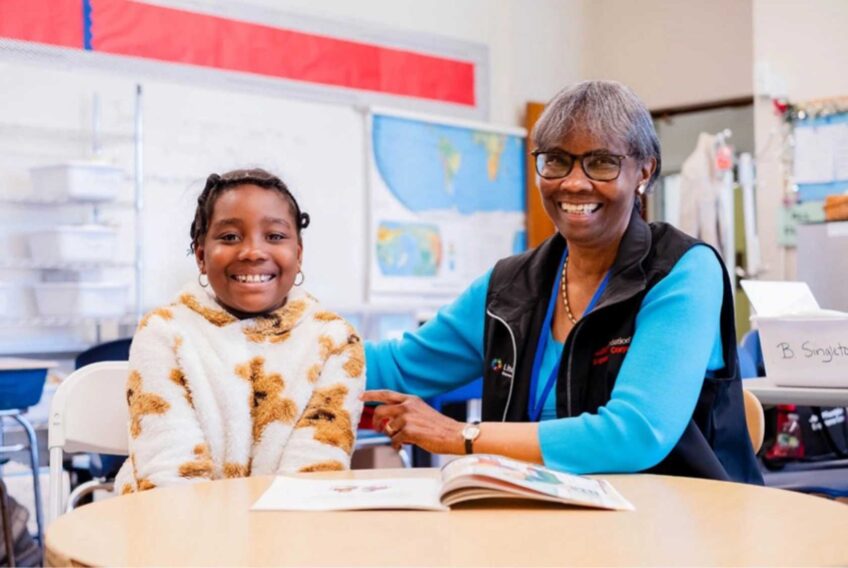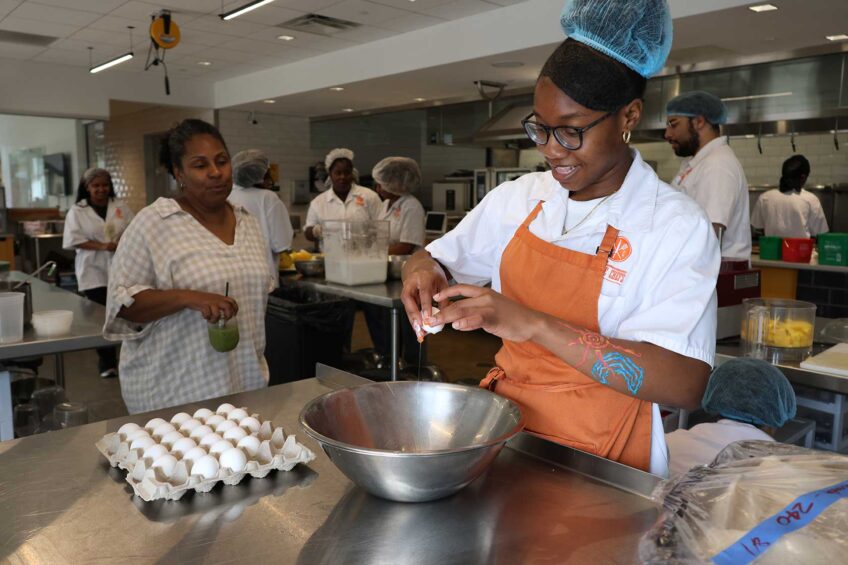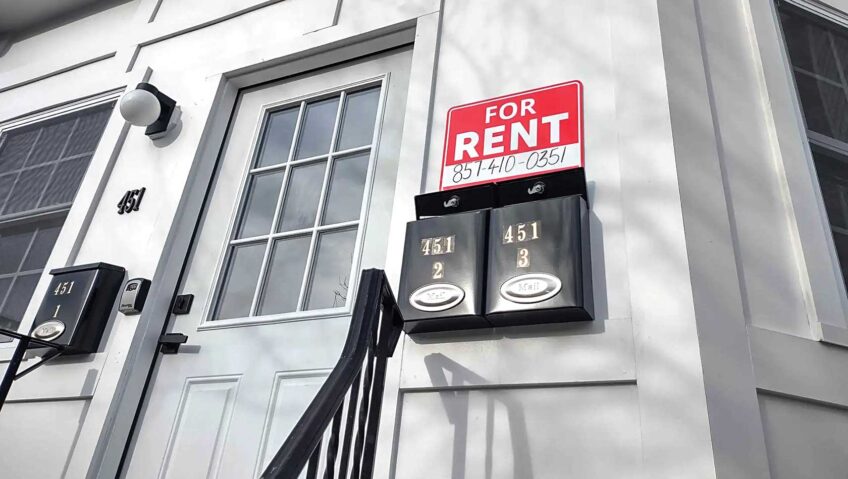Public Health Commission looks to give a ‘Heads Up’ to teen mental health

As evening fell on Dec. 5, over a hundred Boston teens packed into a warmly lit space down the block from Boston City Hall.
On one side of the room — called the “Communicorner” — young people lounged and chatted as a poet clacked out custom poems on a typewriter. Music pulsed, the smell of food wafted, chatter filled the air and by the front door, gleaming silver balloons spelled out what brought them all there: “Heads Up Boston,” a new mental health campaign launched by the Boston Public Health Commission.
“Mental health is not a joke or a figment of a people’s imagination. It’s a serious thing that needs to be shown,” said Zyer Hamilton, a Dorchester teen at the event, who works with the Boston Area Health Education Center, which prepares high schoolers for health careers.
“That’s what this pop-up is doing,” Hamilton continued. “It’s showing people that mental health, ‘hey, it’s real.’ Everyone has something, and we need to acknowledge that.”

Staff pass out merch at the Heads Up Boston Pop-Up Shop downtown, Dec. 6. The event was part of a Boston Public Health Commission campaign focused on encouraging teens to talk about mental health. PHOTO: AVERY BLEICHFELD/BAY STATE BANNER
The one-day pop-up event marked the launch of a new city effort to spark more conversations among young people about their mental health and well-being.
The work comes out of feedback the commission has heard over the past several years focused on concerns around mental health, especially from high-school-aged constituents and younger, said Dr. Kevin Simon, chief behavioral health officer at the Boston Public Health Commission.
“Being able to address this as a direct result of things that we’ve heard from the community is pretty exciting,” he said.
In a series of social media posts, radio spots and ads on bus stops, the Boston Public Health Commission wants to tell Boston’s youth — especially young people from communities of color, the LGBTQ+ community and those who are female — that it’s good to have conversations about how they’re feeling.
“I’d want to convey to any person that is a young person themselves or has a young person that they care about or love, know that their mental health matters and that they shouldn’t be navigating this world, our city alone,” Simon said.
That effort is an important step to empower young people to have more conversations to support their mental health, said Rachel Kim, senior director of implementation and associate director of training at the Baker Center for Children and Families.
“I think it’s a big, big step towards being able to help people to become more mental health literate, more aware and even just more willing to get treatment or get support when they need it,” said Kim, who wasn’t involved in the campaign.
At the heart of the campaign is the goal of destigmatizing such conversations. Simon said, through his work with the commission, he’s seen young people in Boston struggle to know where to turn for support, be less likely to seek help or think that they’re alone in what they’re feeling.
“The effort is really trying to destigmatize all aspects of mental health, whether that’s talking about it, having conversations, seeking help and recognizing that that actually is a strength,” Simon said.
Those kinds of barriers to conversation can have significant impacts for young people in Boston. In a report released in March, detailing statistics around how city residents interact with and are impacted by mental health, the Public Health Commission found that over 40% of Boston Public Schools students in 2021 reported feeling persistent sadness, up almost 20 percentage points from 2015.
The rate of Latinx students experiencing persistent sadness was eight percentage points higher than their white counterparts. Among female students, the rates were 20 percentage points higher. Among LGBTQ+ students, rates were almost twice as high as straight students.
The report also found that most suicide-related indicators — including feeling sad or hopeless for two weeks or more, self-harm, or considering planning — were more frequent compared to previous years.

Stickers were some of the merch available for attendees at the Heads Up Boston Pop-Up Shop downtown, Dec. 6. PHOTO: AVERY BLEICHFELD/BAY STATE BANNER
Black and Latinx students, female students and those in the LGBTQ+ community all reported feeling less close to people at school.
Angelina Cao, another teen with the Boston Area Health Education Center, said that she thinks a lot of young people might be hesitant to talk about mental health topics, especially with older generations who they feel might dismiss the topics.
“I feel like you have to get out of your comfort zone and talk about issues, even when you’re uncomfortable because it’s important,” Cao said. “Because everyone has it.”
Hamilton described personal experience with challenges opening up to older generations in communities of color but said that those tough conversations tended to end productively.
“When I really sat down with [my grandmother] and had open and honest conversation and showed her, ‘Hey, this is a real thing. This can affect me. It has been affecting me for a long time,’ she was able to open up and understand and actually help me get the help that I needed,” Hamilton said.
Supporting youth in starting those conversations may help the adults in their lives get used to talking about topics that they’re less comfortable with, Kim said. Being able to have those conversations and support youth is something Kim said she’s heard adults say they want to do, but they don’t know how to.
Despite the challenges around communication, the topic of mental health is also something that Simon said young people seem eager to consider.
“Youth from this generation definitely have mental health as a top-of-mind idea. They are willing to wrestle with what it means to be in a good, healthy state of mind,” said Simon, citing conversations he’s had with young people in the community.
That engagement showed in the development of the Heads Up campaign, which was an effort that included guidance and input from the BPHC’s Youth Advisory Board, which participated in the selection of Argus, a Boston-based marketing agency, to put together the $1 million campaign, which is being funded through federal American Rescue Plan, or ARPA, funding.
Simon said the voices and faces of youth are also featured in the campaign, including in multiple different languages.
Getting more reputable information out on social media about mental health is also a big plus of the campaign, Kim said, pointing to videos on TikTok and other platforms that aren’t always accurate. For the Heads Up campaign, she said the resources it directs teens to are legitimate strategies she would recommend as a therapist.
She called the campaign a great step in the direction of improving the online mental health information landscape.
Focusing conversations about mental health on factors beyond just conditions and diagnoses, to instead consider general well-being and everyday stressors — like academic struggles and social connections, as well as safety and discrimination — is an important shift, Kim said, and one she said she is seeing gradually happen more frequently in the behavioral health field.
“Everything is built on relationships and interactions,” she said. “Yeah, there’s the neurobiology and genetics; all that stuff that is part of it, but we are so shaped by our experiences with each other.”
It’s something she’s seen coming from young people too. In focus groups run by the Baker Center about how youth are thinking about mental health, Kim said many participants were discussing daily life challenges.
Those shifting conversations parallel — though perhaps more slowly, she said — discussion in the physical and public health spheres to consider factors beyond the medical care provided in hospitals and other facilities, called social determinants of health. Those include things like income, education and access to things like healthy foods or housing.
Under its current leadership, attention to social determinants of health has been a priority for the Boston Public Health Commission.
That kind of change in the mental and behavioral health space can be important to helping patients connect and stick with care, Kim said, pointing to the example of a treatment for depression or low mood called “behavioral activation.” That treatment essentially is sending the patient out to do something fun, especially on a regular basis.
A sports team can be an easy way for patients to regularly engage in an activity, but it can be cost-prohibitive.
“It would be very tone-deaf of me to say this to a family that doesn’t have the funds to sign their kid up for the fancy travel soccer team, and they would say, ‘Well, this therapist has no idea what they’re talking about,’ and they would probably disengage from treatment, right?” Kim said. “And that’s on me because I didn’t take the time to understand their context.”
A shift in who is working in the behavioral health space could also help with that.
“In some of work just talking to youth, they’re like, ‘Yeah, I tried out therapy, but all the therapists were white. They didn’t get it. I didn’t feel like we really connected,’” Kim said.
It’s an issue that the Public Health Commission has identified as well and is launching a program to try to address.
Simon said that earlier this year, the Commission secured a partnership with the University of Massachusetts Boston and Franciscan Children’s Hospital to create pathways for Boston residents from more diverse backgrounds to pursue pathways to careers like licensed mental health counseling and peer recovery.
That program will support 100 community members over the next three years to get certification through UMass and then potentially pursue further training or employment with Franciscan Children’s.
Other groups, too, like the Urban League of Eastern Massachusetts, have started to launch similar efforts to bolster employment in the field.
Part of that work will have to focus on reducing the financial and structural barriers around getting a degree in mental health work, Kim said.
For example, beyond the cost of pursuing degrees, part of the unspoken expectation for an applicant pursuing a doctoral psychology program is volunteer experience in labs, which can be out of reach for students who need to work while also pursuing a degree.
And once in the field challenges still exist. Salaries for community-based care tend to be low, Kim said.
“Diversity in the workforce is a lot of financial investment, and it’s a lot of like structural investment from everything from our policymakers to mental health center leadership and the actual clinical supervisors who work in those spaces to make sure that the therapist can do their best possible work,” Kim said.






